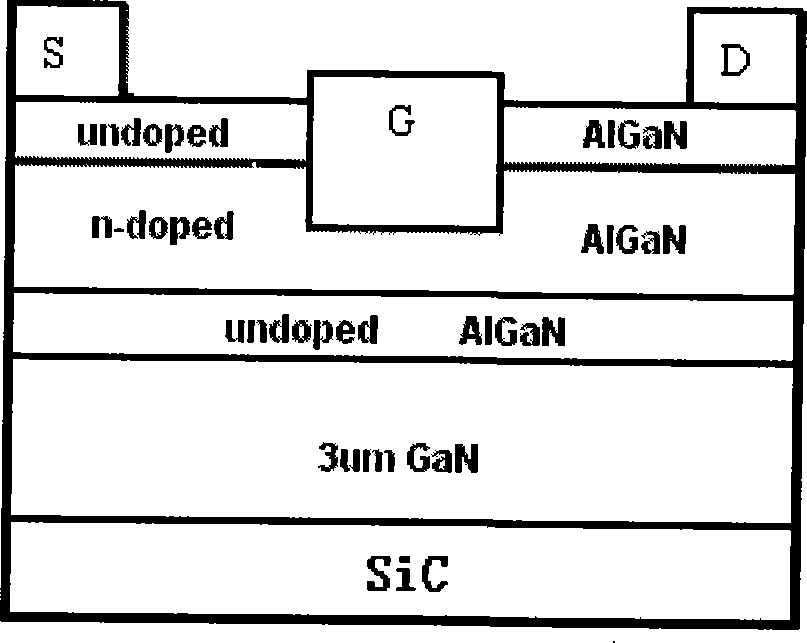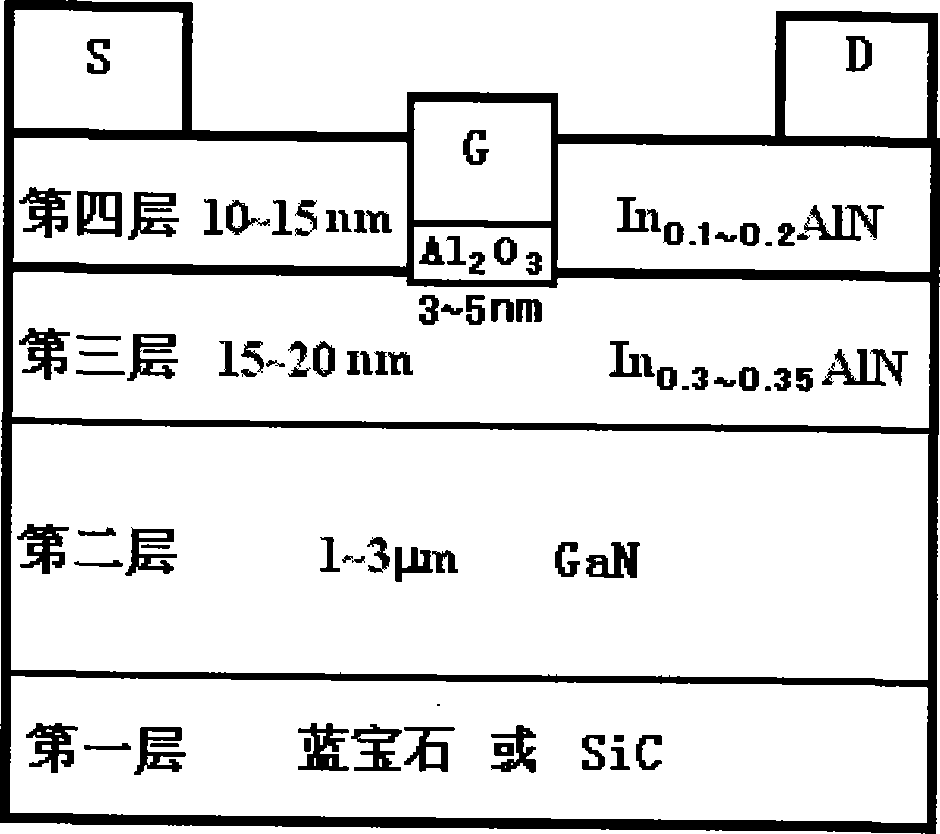InA1N/GaN heterojunction enhancement type high electron mobility transistor structure and production method thereof
A high electron mobility, enhanced technology, applied in the field of microelectronics, can solve the problems of enhanced device injection damage, depletion effect stability to be verified, etc., to achieve increased operating voltage range, high forward threshold voltage, reduced Effect of Small Gate Leakage Current
- Summary
- Abstract
- Description
- Claims
- Application Information
AI Technical Summary
Problems solved by technology
Method used
Image
Examples
example 1
[0039] 1. Epitaxial growth heterojunction materials
[0040] The first step is to grow a GaN buffer layer.
[0041] Use single crystal sapphire as the substrate material to grow the GaN buffer layer in the (0001) direction, that is, first NH at 950℃ 3 And H 2 The sapphire substrate was pretreated at high temperature for 10 minutes in the mixed gas, and then a 30nm low-temperature nucleation layer was grown at 520°C, and then the temperature was raised to 920°C to grow a 1μm thick GaN buffer layer.
[0042] In the second step, the first InAlN layer is epitaxially grown on the GaN layer.
[0043] After the growth of the 1 μm thick GaN buffer layer is completed, the temperature is set to 800° C., and the first InAlN layer with an In composition of 30% is continuously grown, and the thickness of the first InAlN layer is 20 nm.
[0044] In the third step, a second InAlN layer is epitaxially grown on the first InAlN layer.
[0045] After the epitaxial growth on the first InAlN layer is ...
example 2
[0061] 1. Epitaxial growth heterojunction materials
[0062] The first step is to grow a GaN buffer layer.
[0063] Choose a 4H SiC substrate to grow a GaN buffer layer on the Si surface, that is, first NH at 950℃ 3 And H 2 The sapphire substrate was pretreated at high temperature for 10 minutes in the mixed gas, and then a 30nm low-temperature nucleation layer was grown at 520°C, and then heated to 920°C to grow a 2μm thick GaN buffer layer.
[0064] In the second step, the first InAlN layer is epitaxially grown on the GaN layer.
[0065] After the growth of the 2 μm thick GaN buffer layer is completed, the temperature is set to 800° C., and the first InAlN layer with an In composition of 33% is continuously grown, and the thickness of the first InAlN layer is 18 nm.
[0066] In the third step, a second InAlN layer is epitaxially grown on the first InAlN layer.
[0067] After the epitaxial growth on the first InAlN layer is completed, a temperature of 800° C. is set, and a second...
example 3
[0083] 1. Epitaxial growth heterojunction materials
[0084] The first step is to grow a GaN buffer layer.
[0085] Choose a 4H SiC substrate to grow a GaN buffer layer on the Si surface, that is, first NH at 950℃ 3 And H 2 The sapphire substrate was pretreated at high temperature for 10 minutes in the mixed gas, and then a 30nm low-temperature nucleation layer was grown at 520°C, and then the temperature was raised to 920°C to grow a 3μm thick GaN buffer layer.
[0086] In the second step, the first InAlN layer is epitaxially grown on the GaN layer.
[0087] After the growth of the 3 μm thick GaN buffer layer is completed, the temperature is set to 800° C., and the first InAlN layer with an In composition of 35% is continuously grown, and the thickness of the first InAlN layer is 15 nm.
[0088] In the third step, a second InAlN layer is epitaxially grown on the first InAlN layer.
[0089] After the epitaxial growth on the first InAlN layer is completed, a temperature of 800° C. ...
PUM
| Property | Measurement | Unit |
|---|---|---|
| Thickness | aaaaa | aaaaa |
| Layer thickness | aaaaa | aaaaa |
| Thickness | aaaaa | aaaaa |
Abstract
Description
Claims
Application Information
 Login to View More
Login to View More - R&D
- Intellectual Property
- Life Sciences
- Materials
- Tech Scout
- Unparalleled Data Quality
- Higher Quality Content
- 60% Fewer Hallucinations
Browse by: Latest US Patents, China's latest patents, Technical Efficacy Thesaurus, Application Domain, Technology Topic, Popular Technical Reports.
© 2025 PatSnap. All rights reserved.Legal|Privacy policy|Modern Slavery Act Transparency Statement|Sitemap|About US| Contact US: help@patsnap.com



